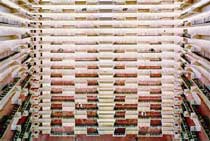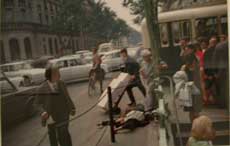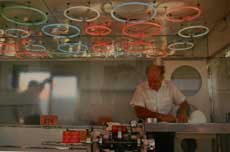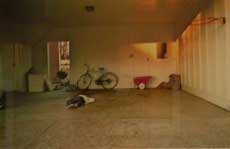This week’s Weekly has my review of the PMA’s Mavericks of Color exhibit. Below is the review. And here’s Libby’s post on the show.

Keeping It Real
A few years ago I saw a color photograph by German photographer Andreas Gursky at the Pittsburgh Center for the Arts. The piece showed the floors of a hotel as seen from the hotel’s atrium, and it was enormous. I was told by the curator that the framed photo weighed 500 pounds. It seemed to be a photograph that thinks it’s a painting. (I did some googling and found what I think is the picture, Gursky‘s “Hyatt Atlanta” seen here.)
But color photography’s point of reference hasn’t always been painting. As you can see in the wonderful 50-photo “Mavericks of Color Photography From the Collection” exhibit at the Philadelphia Museum of Art, the roots of the medium are in shots that are small, documentary and humble — and decidedly photo-like.
Early practitioners like William Eggleston and Joel Meyerowitz (and locally David Graham, included in “Mavericks” with one great shot from 1979) came to color through black-and-white photography. Back in the ’60s and ’70s black-and-white was considered the standard for fine art photography, and color was looked down upon as brassy, populist and commercial.

Color film was also difficult and expensive to process and print. Many photographers stayed away for those reasons, preferring instead the familiarity of black-and-white processing and printing.
But Meyerowitz, Eggleston and a few others (including Eliot Porter in the ’50s before them) found their way to color and stayed there. Color was a good fit with the subject matter they were interested in-street scenes and people for Meyerowitz, socioeconomic milieus for Eggleston, and birds and nature for Porter. These are things that require a certain photo-verite and make real-world color the perfect choice. (image right is Meyerowitz‘ “Fallen Man, Paris”)
The color photographs in this show seem to flow from the standard photo traditions of street photography, nature photography and portraiture. But the aesthetic in each shot is “real” as opposed to precious. And what you see isn’t just a view-it has a point of view.
Perhaps the impulse to verity comes from the rise of photojournalism or perhaps from the influence of TV and film, but the color photos in this exhibit all have the “you are there” quality that feels a little like tonight’s news.
Meyerowitz’s works-which focus on people, signs and patterns in serendipitous arrangements-have a quizzical nature to them. They’re deadpan compositions that invite the viewer to participate in figuring out their meaning. This generosity of spirit — one that includes the viewer and leaves space for interpretation — is characteristic of most of the work in this show.

“Fallen Horse, Spain” and “Fallen Man, Paris,” two great Meyerowitz pictures from 1967, are mini essays about life, accidents and animal behavior. His “Danbury Fair, Connecticut,” (left) a shot of an elderly man working at the state fair, documents a time and place. But by framing the shot to show something odd (there’s a grid of round neon lights above the man’s head, making him look like he’s under a field of haloes), the artist provides some room for the viewer to weigh in. Is it a joke? What’s the joke? You decide.
William Christenberry’s portraits of sheds and shacks in his beloved South are tiny, humble and snapshot-like. Like much of the work here, they embrace the conceit that all things are worthy.

Eliot Porter’s photos are backyard safari shots of sparrows, rocks and lichens that also sing of wonder in the ordinary. William Eggleston brings color-and kindness-to photos that remind you of Diane Arbus and seem to ask what’s wrong with this picture. (image is by Eggleston. It’s a little hard to see but it’s a child sprawled face down on the oil-stained floor of an empty two car garage)
Today color photos like Gursky’s want to pick a fight with painting. None of the works at the PMA cares about painting. They’re squarely in the photo tradition. The show’s a welcome reminder of the power of a well-made color image no matter what the size.
“Mavericks of Color Photography From the Collection”
Through Nov. 27. Julien Levy Gallery, Philadelphia Museum of Art, 26th St. and the Pkwy. 215.763.8100. www.philamuseum.org
sketchesMei-ling Hom emailed to say she’s preparing for a solo exhibit at the Smithsonian’s Arthur M. Sackler Gallery. My friend Libby Rosof and I visited Hom’s studio to see the work: 35 cloud forms sculpted in the artist’s signature steel chicken wire mesh. More news from the studio visit next week. The Sackler show will run Sat., Aug. 27 through Sun., March 5. See Libby’s post on the studio visit.
And in Manayunk, a new Ann Northrup mural is at the drawing stage on the Propper Brothers building. The theme is ovarian cancer awareness, and the artist’s design shows a sublime landscape of rocks, sea and sky with figures symbolizing cancer survivors dancing in the sunset. Northrup’s assisted on the Mural Arts Program project by recent PAFA grad Gabe Tiberino and 78-year-old Kitty Hankins. The mural dedication is on Sept. 22. [Ed. note: Stay tuned for a post with some mural pictures.]









